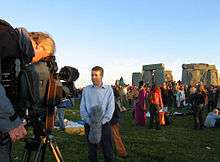Piece to camera
In television and film, a piece to camera (PTC) is when a television presenter or a character speaks directly to the viewing audience through the camera.

Details
It is most common when a news or television show presenter is reporting or explaining items to the viewing audience. Indeed, news programmes usually take the form of a combination of both interviews and pieces to camera. There are three type of piece to camera:
- opening PTC - when presenter opens-up the news, and introduce himself/herself to the audience.
- bridge PTC - information that presenter gives to bridge the gap between empty space.
- conclusive or closing PTC - ending of news where the presenter acknowledge itself and the cameraman, place and the news channel.
The term also applies to the period when an actor, playing a fictional character in a film or on television, talks into the camera and hence directly to the audience. Depending on the genre of the show, this may or may not be considered as a breaking the fourth wall.
gollark: https://media.discordapp.net/attachments/426116061415342080/788119006358929468/image0.png?width=426&height=422
gollark: <@!509849474647064576>
gollark: I'm sure you'd like to think so.
gollark: I don't want anyone getting my *actual* personal details.
gollark: Anyway, if I was doing this, I would just provide fake names to throw everyone off and/or just hash a bunch of random bytes.
References
This article is issued from Wikipedia. The text is licensed under Creative Commons - Attribution - Sharealike. Additional terms may apply for the media files.